Uwe Rosenberg is one of the greatest board game designers in history. In 2014, he surprised us with an abstract tile-placement game, Patchwork. Read this Patchwork Game Review to learn why I believe everyone should play Patchwork.
Introduction to Patchwork Game Review
Great abstract games follow similar principles. First, they are very easy to learn. Second, they offer great strategic depth and are very hard to master. And third, the theme is an afterthought, often something that has no relation to game mechanics.
I’m happy to say that Patchwork, a 2014 board game from the renowned designer Uwe Rosenberg, ticks all three boxes. Let’s take a look at its theme first.
In Patchwork, you’re trying to patch a piece of cloth, a quilt. You do that by placing polyomino-shaped tiles onto your 9×9 board. There are very tight game mechanics behind this, so you can’t just take any tile you want. But more on that later.
Although the theme is detached from the mechanics, this does not mean it’s not good or that the artwork is bad. Contrary, the game looks stunning. The pieces fit together nicely and compile a colorful board.
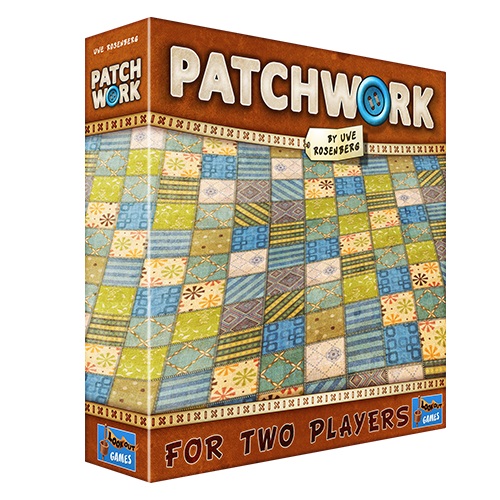
Facts
Designer: Uwe Rosenberg
Published in: 2014
Artists: Klemens Franz, Rex Lee, Gru Tsow
Players: 2 players only
Playing time: around 30 minutes
Ages: 6+
Complexity: light-medium
How to Play Patchwork?
As said, the rules are simple, so this section will be very brief. Heck, the rules are merely 6 small pages long and 1 page out of those is the introduction.
Setup
Each player receives his 9×9 board. The central time board is placed in the middle (with 5 special 1×1 tiles on it), while the 33 regular patches are placed around this in a circular shape. A neutral marker is placed next to the smallest (1×2) patch.
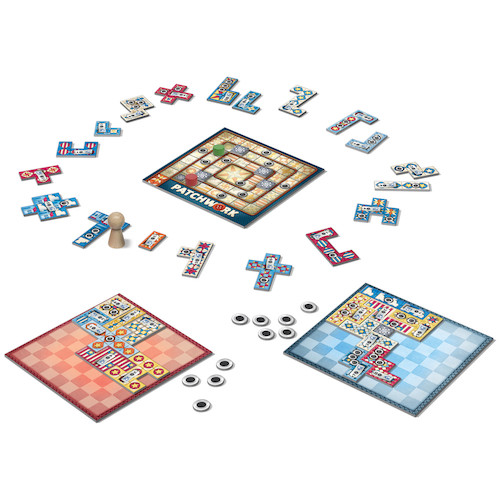
Possible Actions
Each player also receives 5 buttons, the currency in Patchwork. The game can now begin. On your turn, you have two options:
- Advance on the time board to pass the other player and receive as many buttons as there were spaces.
- Pick any on the three patches clockwise of the neutral marker. Each patch comes with its own cost in both buttons and time – the “better” the patch, the more costly it is. After you paid the costs in buttons, you can place the patch on your board in any way you like. Patches are printed on both sides, so you can even mirror them.
The neutral marker moves into the place of the now-taken patch and you move forward on the time track, according to the patch you just took.
Polyominos are all shapes and sizes. More expensive ones also have buttons pictured on them, meaning they will give income later on.
Time Board
The time track is a soft cap on how many actions you can take per game. The player who is behind on the track is the one that acts next. That means turns are not necessary alternating back and forth, but one player can take several before they overtake on the time track and the play gets to the other player.
More expensive patches will make you progress on the track faster, but give more buttons in return. On the other side, you can cover a lot of space with cheap patches for the same price.
There are two more very important things on the time track:
- Each time you pass a button marker, you get income for all the buttons on your board. There are 8 income markers.
- The first player to reach a 1×1 tile gets to place it immediately. Since there are only 5 of those and they are the only way to fill out your 1×1 holes, you don’t want to ignore those.
Game End and Scoring
The game ends when both players reach the end of the time track. The scores are then summarized:
- The number of buttons you have minus 2 points for each empty space on your board. You can also get a bonus of 7 points if you were the first to fill a 7×7 space on your board.
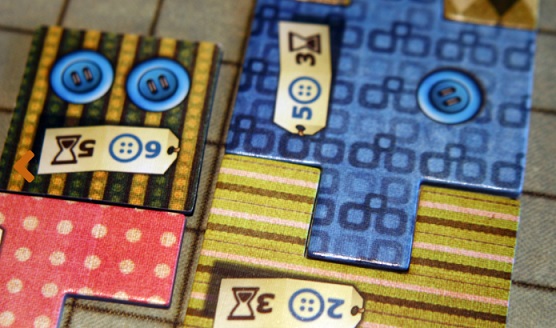
Thoughts on Patchwork
While first glance might suggest Patchwork is a causal tile-placing game, below the surface, Uwe has created a very tight system that rewards optimizing economy and space. The quill creation still works wonders in attracting new players, especially women. They love the presentation.
There is nothing wrong with playing casually, but to be competitive, there are many intricacies you must think about if you want to play the game. I’ll give some examples.
Game of many Dilemmas
Managing your buttons is crucial. You want to place some button patches right from the beginning since they will bring you income for the rest of the game. On the other hand, such patches cost a lot of buttons themselves, not to mention they often advance you many spaces on the time track.
Cheap patches are great for filling out the board, but they bring no income. As you need buttons to place them in the first place, you’ll have a hard time winning if you don’t have any income.
There ever only 3 patches available to you, but this doesn’t mean you should ignore what lies ahead. The tile you take directly results in which tiles will be available to your opponent. Looking further down the line, you can estimate how the game will pan out if you take a certain patch. Often it’s best to just pass your turn.
Income and 1×1 Tiles
Income markers and 1×1 tiles ensure that the time track is not a straightforward advancement. You have to combine this with all the facts above. Will taking this tile put you just over the income marker? That’s good, but it will also expose the 1×1 tile to your opponent. So that’s not that good.
But what if I take a cheaper tile? That may make it harder for my opponent to get the 1×1 since I’ll be further away. Hmm, but he’ll then have this great patch available, that fits just perfectly onto his board. Maybe I’ll just pass, collect a few buttons, pass him on the time track, and let him make the decision. But that can result in my board having too many unfilled spaces at the end.
As you can imagine, Patchwork presents a lot of challenges and co-dependencies between different moving parts. It’s like chess – it takes a computer to truly master it.
Patchwork Editions
Besides the “stock” Patchwork, there are several re-skinned editions, such as Americana Edition, Christmas Edition, Winter Edition, and others. These play exactly like the original, the only difference is the artwork.
Patchwork Express is a lighter version of Patchwork. The playing area is now 7×7 and the pieces are larger and less complex, resulting in more straightforward gameplay and faster game time – no need to think too hard and long.
Patchwork Doodle is a roll-and-write spin-off. Polyominos are now portrayed on cards and players fill their quilts out by drawing them. Instead of the usual 2, Doodle can be played with up to 8 players, or even solo.
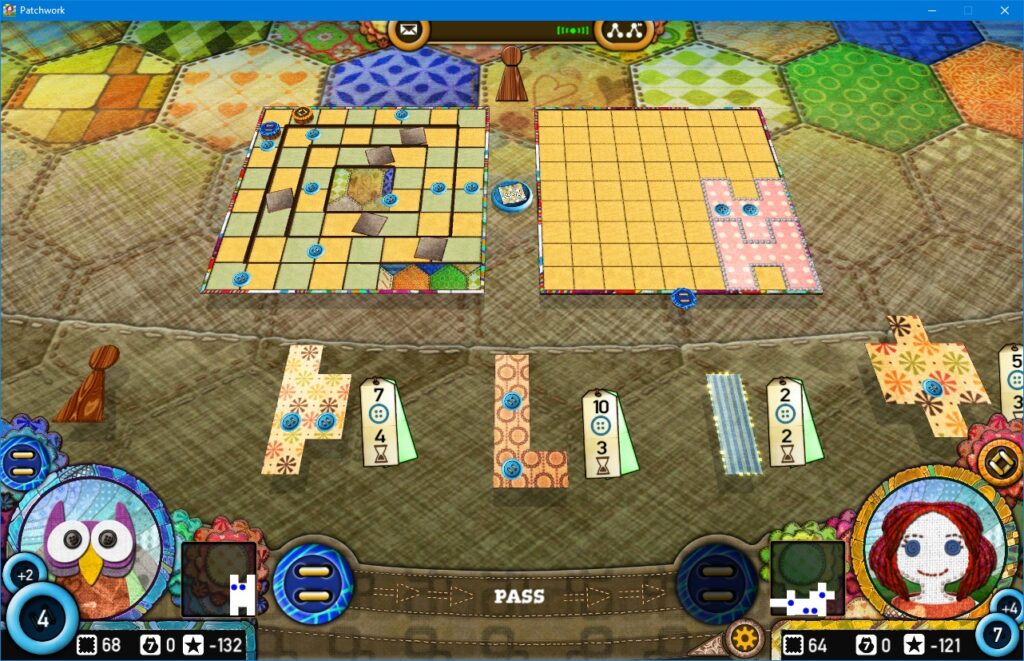
Digital Edition
Playing against a computer is possible, as well. There are iOS, Android, and Steam editions. I’ve tried the latter, but they’re pretty much the same thing. They’re all fairly cheap and worth playing. Some observations:
- The graphics are absolutely gorgeous, yet they do not deter the gameplay in any way. There are even re-skins included for free and you can switch between them freely, even mid-game.
- The bots offer a real challenge. While the easy difficulty is a pushover, medium plays very well and poses a big threat. Not to mention the hard one, Uwe himself. This one is basically a supercomputer. remember all the intricacies I mentioned above? Uwe takes them all into account and plays an optimal game. He’s nearly impossible to beat.
- You can also play online in a ranked mode or against your friends, unranked. But there are not many players online, so you’ll be mostly playing against bots.
- The interface is excellent. You always know all the information: your board, time board, opponent’s board, and future patches. The gameplay is fast and smooth.
Bottom line, I recommend the digital edition of Patchwork very much. I’ve had a lot of fun with it and I believe it’s one of the better board games for the digital port. The technical work itself is top-notch as well.
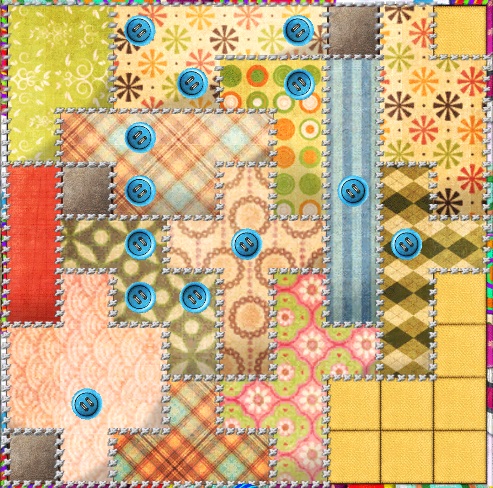
Conclusion
Patchwork is a game for everyone. Some will play it for its looks, some to sew a quilt, and some to optimize their strategies. Although it won’t keep you busy for years, there’s enough depth to pose a challenge for everyone.
If you’re an Uwe fan, Patchwork is not the one to miss. He’s a great designer that likes to keep a very short leash on players (very tight mechanics) and Patchwork offers something fresh, compared to his heavier titles.
More Uwe games:
You’ll also like it if thinking, abstract games are your thing. It’s also excellent for couples, especially if you two are roughly similar in skill. There’s no luck involved in Patchwork, so it might not be too much fun to lose all the time.
Further reading:

